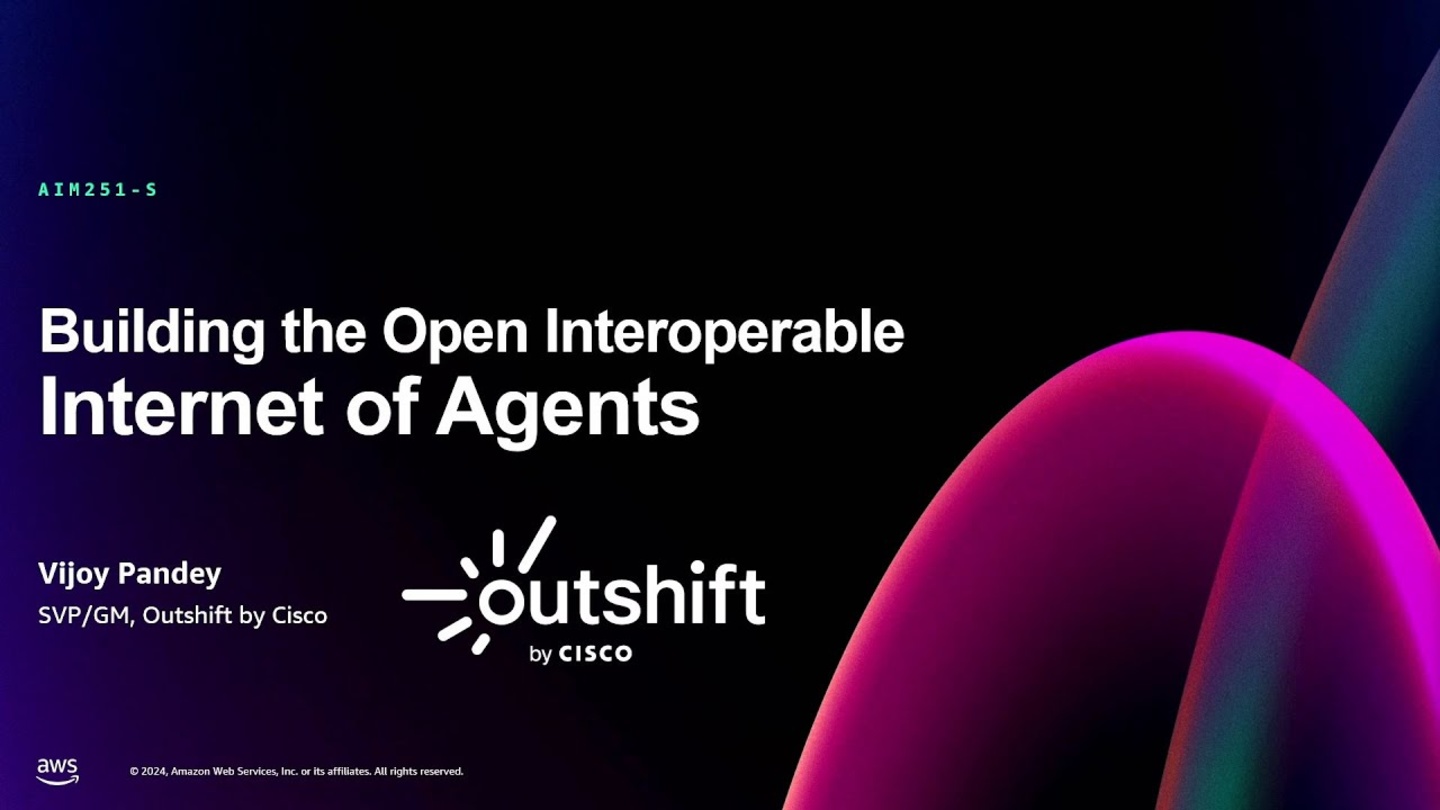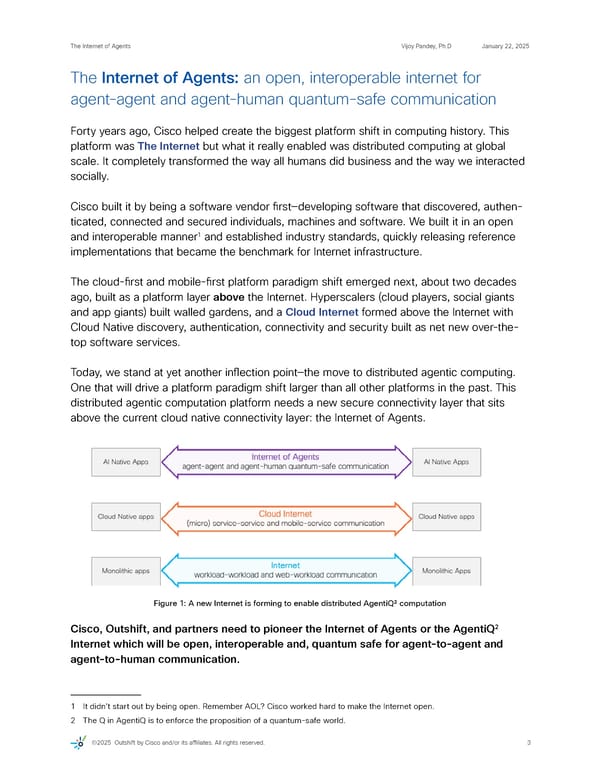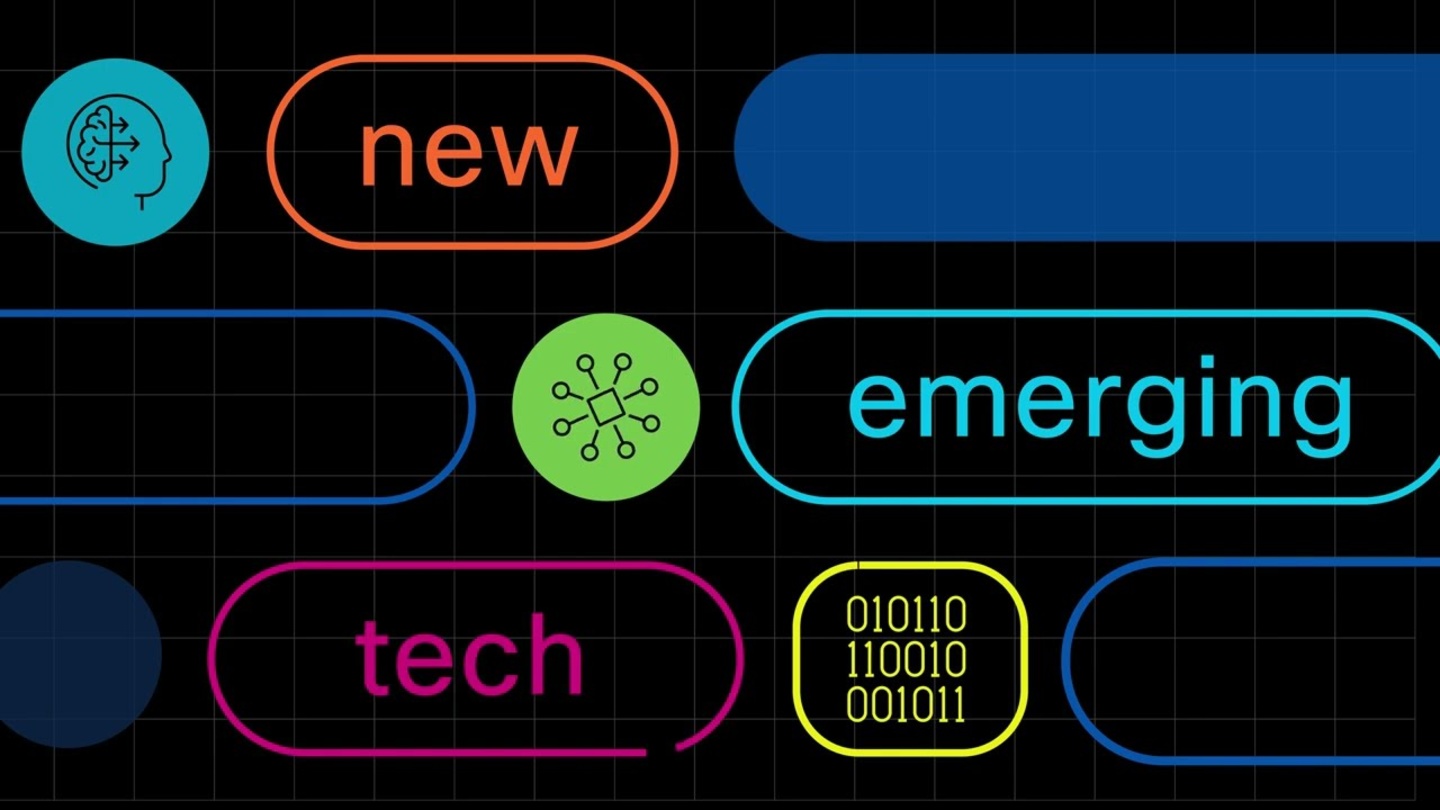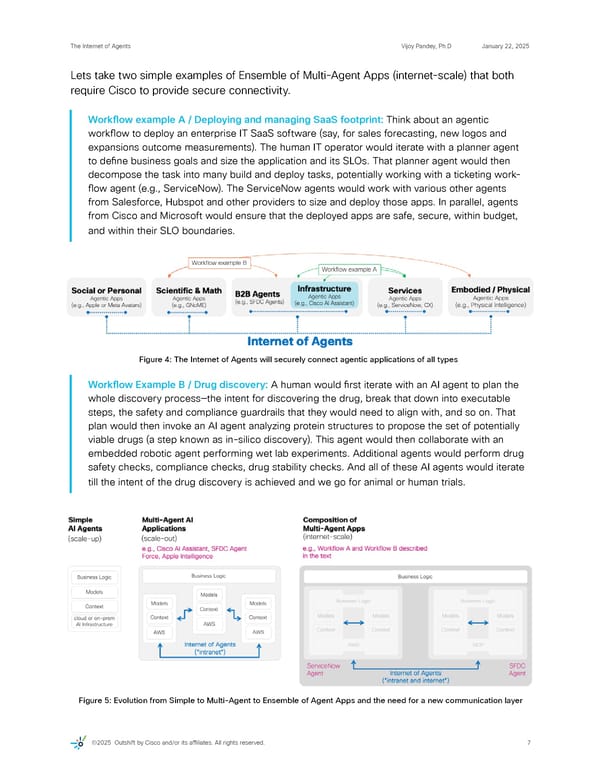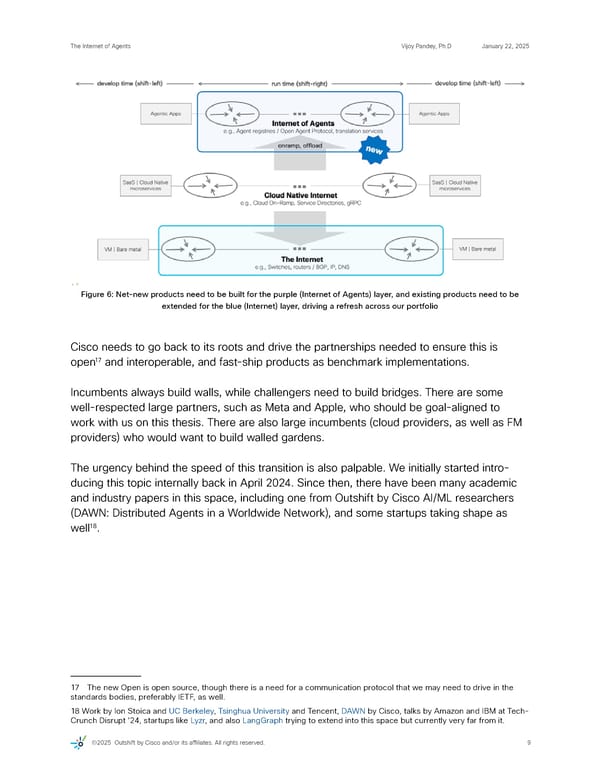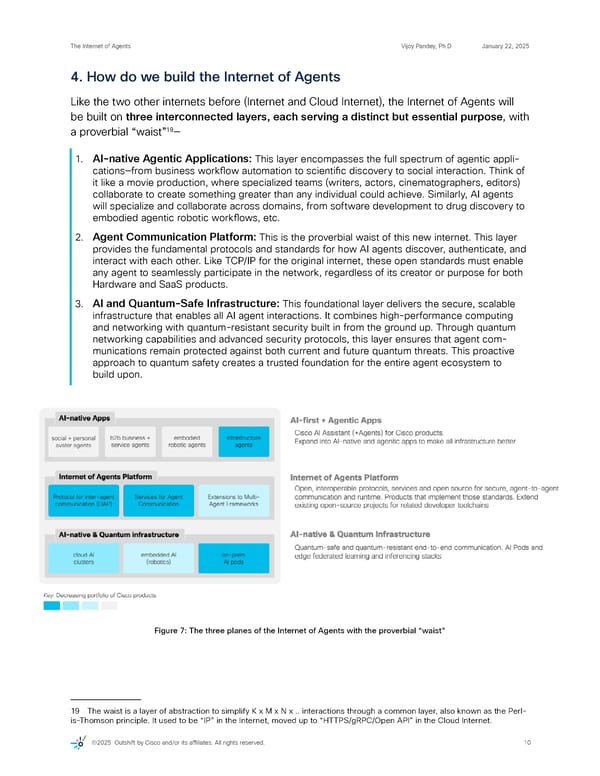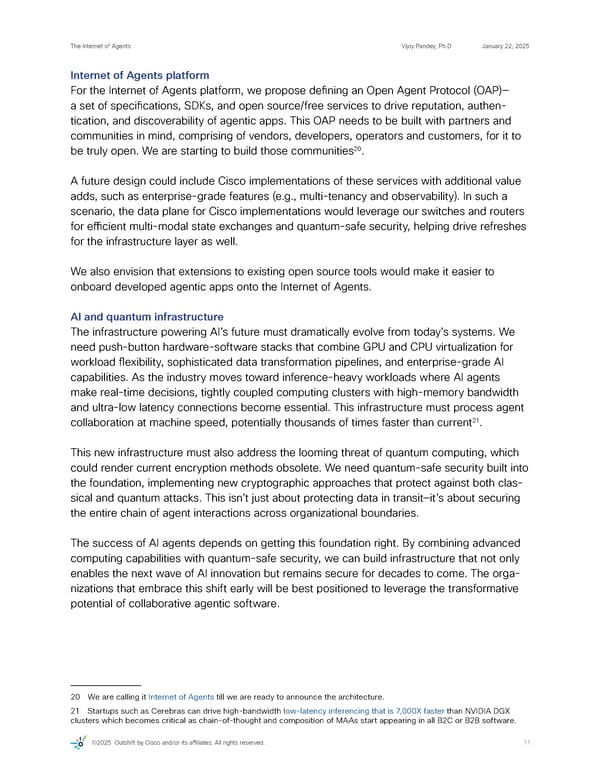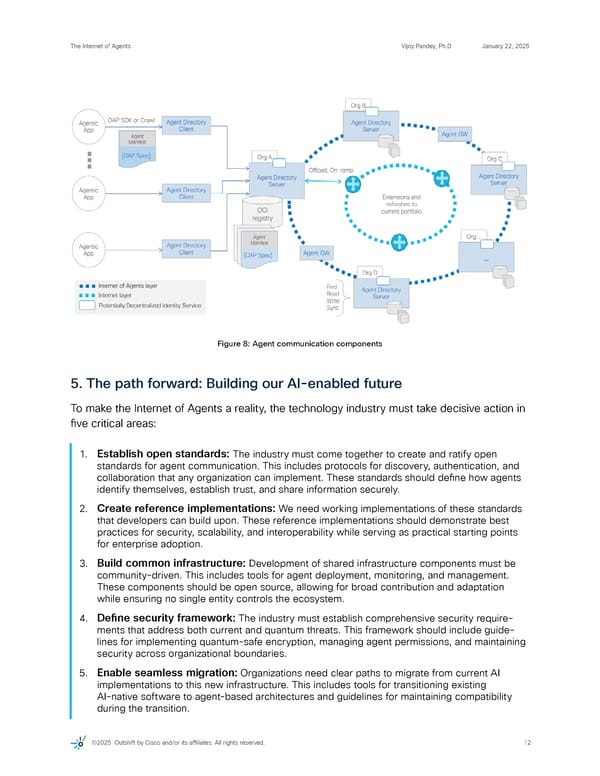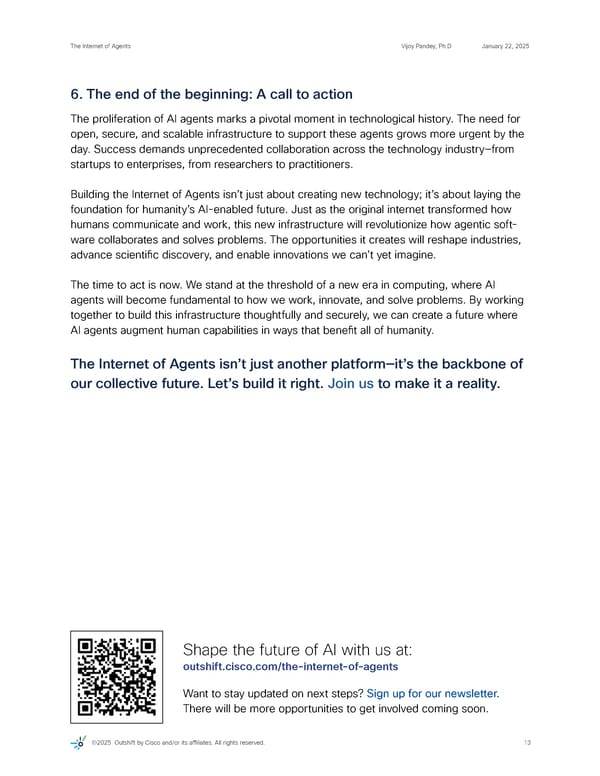The Internet of Agents | Digital paper
This document by Vijoy Pandey, Ph.D., explores the concept and future of interconnected autonomous agents, published by Outshift by Cisco.
The Internet of Agents Vijoy Pandey, Ph.D January 2025
The Internet of Agents Contents 1. A new computing paradigm: Beyond deterministic systems 4 2. How will this all come together? 5 3. The Internet of Agents 8 4. How do we build the Internet of Agents 10 5. The path forward: Building our AI-enabled future 12 6. The end of the beginning: A call to action 13 ©2025 Outshift by Cisco and/or its afÏliates. All rights reserved. 2
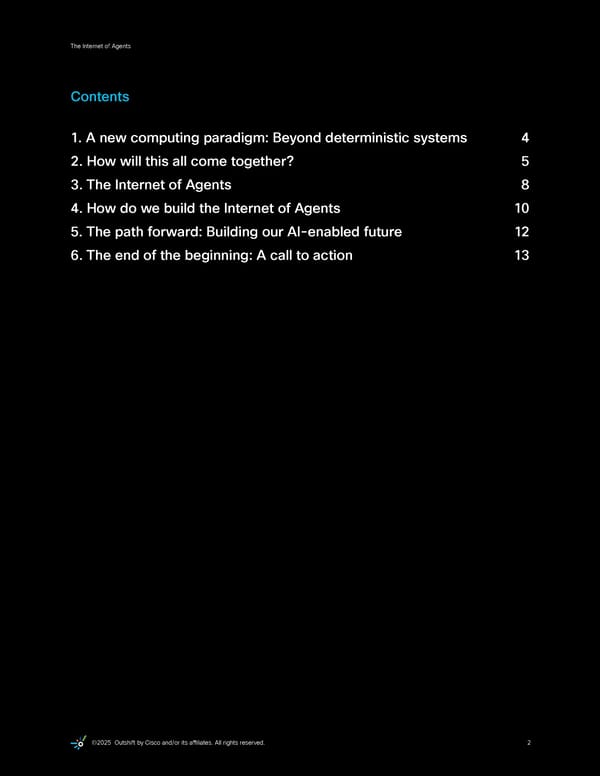
The Internet of Agents Vijoy Pandey, Ph.D January 22, 2025 The Internet of Agents: an open, interoperable internet for agent-agent and agent-human quantum-safe communication Forty years ago, Cisco helped create the biggest platform shift in computing history. This platform was The Internet but what it really enabled was distributed computing at global scale. It completely transformed the way all humans did business and the way we interacted socially. Cisco built it by being a software vendor first—developing software that discovered, authen- ticated, connected and secured individuals, machines and software. We built it in an open 1 and interoperable manner and established industry standards, quickly releasing reference implementations that became the benchmark for Internet infrastructure. The cloud-first and mobile-first platform paradigm shift emerged next, about two decades ago, built as a platform layer above the Internet. Hyperscalers (cloud players, social giants and app giants) built walled gardens, and a Cloud Internet formed above the Internet with Cloud Native discovery, authentication, connectivity and security built as net new over-the- top software services. Today, we stand at yet another inflection point—the move to distributed agentic computing. One that will drive a platform paradigm shift larger than all other platforms in the past. This distributed agentic computation platform needs a new secure connectivity layer that sits above the current cloud native connectivity layer: the Internet of Agents. Figure 1: A new Internet is forming to enable distributed AgentiQ2 computation 2 Cisco, Outshift, and partners need to pioneer the Internet of Agents or the AgentiQ Internet which will be open, interoperable and, quantum safe for agent-to-agent and agent-to-human communication. 1 It didn’t start out by being open. Remember AOL? Cisco worked hard to make the Internet open. 2 The Q in AgentiQ is to enforce the proposition of a quantum-safe world. ©2025 Outshift by Cisco and/or its afÏliates. All rights reserved. 3
The Internet of Agents Vijoy Pandey, Ph.D January 22, 2025 To jump directly to the requirements, and how we need to build in this space, you can start reading from section 3, or section 5. 1. A new computing paradigm: Beyond deterministic systems 3 Largely, computing has been deterministic in nature for all these decades with probabilistic (stochastic) computing being relegated to special use cases (ML models) or quantum com- puting use cases. Generalized probabilistic computing only took shape after the democrati- zation of language foundation models (LLM) such as ChatGPT in November 2022. It quickly became evident that foundation model (FM) based AI-native applications, especial- ly in the form of agents, are going to disrupt all human work. This disruption will start with software and IT work, before transforming all knowledge, services, physical work, and all social interactions. Right now, we are scratching the surface of FM-based assistants and agents, as they help us with multi-modal content-based outcomes such as audio, video, images and text (includ- ing writing code). FMs are capable of a lot more as they inherently build semantic relationships between the components of any language. That language is a communication language for now—how nouns, verbs, adverbs, etc. combine to form sentences. But we are already seeing AI models and FMs building semantic relationships for other languages such as: • Health and medical sciences: the language of how proteins combine and fold. For ex- 4 ample, the design of new protein molecules through an FM such as EvolutionaryScale , 5 6 Isomorphic Labs, Noetik , or AlphaFold , where the latter has been used to predict the structure of more than 200 million protein structures, allowing its founders to win a Nobel Prize in Chemistry • Material science: the language with which molecules combine to create materials. For example, GNoME that predicted structures for 2.2 million new materials, 700 of which 7 are now being created and tested in labs. • Embodied AI / Agents: the language of how physical actuators combine to create 3 We won’t go into the history of neural networks here, as they evolved from vanilla neural networks in the 1960s to con- text-based transformers like GPT or Gemini in 2017. 4 EvolutionaryScale Launches with ESM3: A Milestone AI Model for Biology, Business Wire 5 AI-native precision immunotherapies for cancer, Noetik 6 AlphaFold 3 predicts the structure and interactions of all of life’s molecules, Google Blog 7 Google DeepMind’s new AI tool helped create more than 700 new materials, MIT Technology Review ©2025 Outshift by Cisco and/or its afÏliates. All rights reserved. 4
The Internet of Agents Vijoy Pandey, Ph.D January 22, 2025 movement. These combined with other embodied AI models such as vision transformer models (ViT) are creating a new paradigm in robotics where robots can learn new physical skills on the fly through learning, making them deployable in any physical work 8 use case , eliminating purpose-built designs. Even Waymo, Nuro and Wayve are using 9 FM-based agents to add new skills to their existing self-driving models and fleets . These foundation models of all kinds are just now beginning to reason, plan, have memory and think about ambiguous objectives. These are hard problems yet to be solved for, but progress is being made quarterly. Additionally, with consumer, social and enterprise companies’ push towards creating per- sonalized virtual agents (including avatars for social networks) for every facet of how we in- teract for B2B and B2C use cases, it’s easy to comprehend how AI-native agents will disrupt 10 all human work. This market is slated to be larger than $4T in size over the next 5 years . 2. How will this all come together? Today, most AI-native assistants (AI-native agents are still in their infancy) are being built as Simple Agents and leveraging singular foundation models. But, just like a single human cannot answer all questions of all kinds (asking an ace software engineer why you are having chest pain is bound to end in disaster, literally), the dream of Artificial General Intelligence (AGI) is still years away. What has been explored, though, is just like humans, many subject matter expert (SME) 11 AI-native agents can collaborate to solve for larger, harder, more ambiguous problems . These SME agents have the advantage of being more accurate and more efÏcient, and via collaboration, have shown to perform much better than the current state of the art one-shot (e.g., GPT-4o) or chain-of-thought (e.g., Open AI o1) foundation models. 12 As Erik Brynjolfsson and team have shown , it is far more pragmatic to think of jobs and complex problems as a collection of tasks, and it is these tasks which can be automated more easily by agentic AI. We have seen similar scaling challenges before. Software and infrastructure get built as a single entity, then scale up, then scale out—first within a vendor’s market boundary, and then beyond. 8 Inside the Billion-Dollar Startup Bringing AI Into the Physical World, Wired, and Mentee Robotics where Cisco is an investor 9 A Powerful AI Breakthrough Is About to Transform the World, Wall Street Journal 10 The AI Opportunity, Sequoia Capital AI Ascent and State of the Open Cloud, Battery Ventures 11 The Rise of Agentic Workflows in AI, Andrew Ng and Networks of Networks: Complexity Class Principles Applied to Compound AI Systems Design, Ion Stoica et.al., UC Berkeley 12 What can machines learn and what does it mean for occupations and the economy? MIT Sloan, Erik Brynjolfsson ©2025 Outshift by Cisco and/or its afÏliates. All rights reserved. 5
The Internet of Agents Vijoy Pandey, Ph.D January 22, 2025 Figure 3: Evolution of agentic applications Some vendors (including Cisco) have started building these Multi-Agent Applications (MAAs), where multiple foundation and ML models are combined with traditional determinis- tic software to solve for a bigger problem (scale-out in the figure above) such as the univer- sal Cisco AI Assistant, or Salesforce Agentforce. Tools for this paradigm are in early-stage 13 advancements and have much potential ahead . Multi-Agent Apps (MAAs) are the “intranet” equivalent of agentic computation. The next logical step in the evolution will be to create an ensemble or workflows of MAAs (internet-scale, in the figure above). This Ensemble of MAAs would collaborate across ven- dor boundaries and across the Internet to solve for larger business (or personal or social or 14 physical) workflows . An Ensemble of MAAs are the “internet” version of agentic computation. 13 LangGraph and Crew.ai are examples of two currently popular tools 14 Satya Nadella on the BG2 Podcast with Bill Gurley and Brad Gerstner ©2025 Outshift by Cisco and/or its afÏliates. All rights reserved. 6
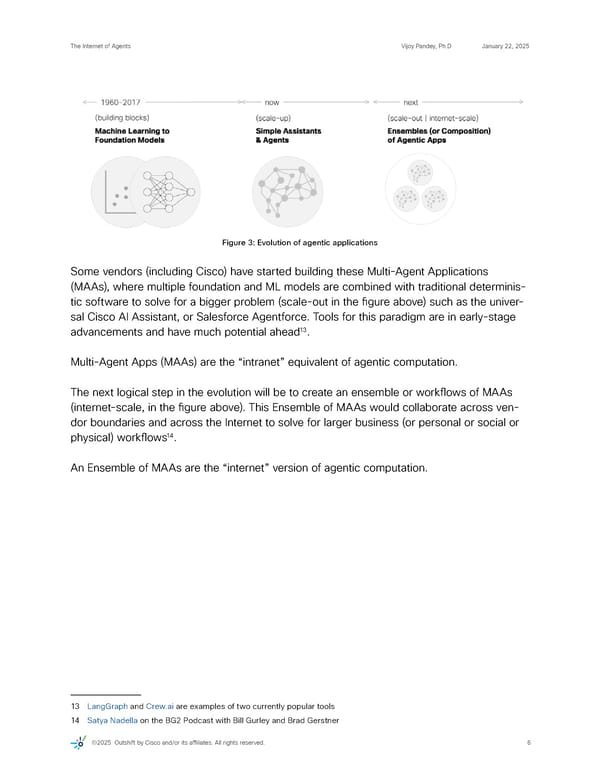
The Internet of Agents Vijoy Pandey, Ph.D January 22, 2025 Lets take two simple examples of Ensemble of Multi-Agent Apps (internet-scale) that both require Cisco to provide secure connectivity. Workflow example A / Deploying and managing SaaS footprint: Think about an agentic workflow to deploy an enterprise IT SaaS software (say, for sales forecasting, new logos and expansions outcome measurements). The human IT operator would iterate with a planner agent to define business goals and size the application and its SLOs. That planner agent would then decompose the task into many build and deploy tasks, potentially working with a ticketing work- flow agent (e.g., ServiceNow). The ServiceNow agents would work with various other agents from Salesforce, Hubspot and other providers to size and deploy those apps. In parallel, agents from Cisco and Microsoft would ensure that the deployed apps are safe, secure, within budget, and within their SLO boundaries. Figure 4: The Internet of Agents will securely connect agentic applications of all types Workflow Example B / Drug discovery: A human would first iterate with an AI agent to plan the whole discovery process—the intent for discovering the drug, break that down into executable steps, the safety and compliance guardrails that they would need to align with, and so on. That plan would then invoke an AI agent analyzing protein structures to propose the set of potentially viable drugs (a step known as in-silico discovery). This agent would then collaborate with an embedded robotic agent performing wet lab experiments. Additional agents would perform drug safety checks, compliance checks, drug stability checks. And all of these AI agents would iterate till the intent of the drug discovery is achieved and we go for animal or human trials. Figure 5: Evolution from Simple to Multi-Agent to Ensemble of Agent Apps and the need for a new communication layer ©2025 Outshift by Cisco and/or its afÏliates. All rights reserved. 7
The Internet of Agents Vijoy Pandey, Ph.D January 22, 2025 And for the foreseeable future, there will always be humans in the loop for critical tasks or decisions, even with increasing agency provided to these multi-agent apps. This also aligns 15 with Cisco’s commitment to responsible AI development , which emphasizes transparency, fairness, and human oversight in all AI software. By building human-in-the-loop mechanisms directly into the Internet of Agents architecture, we ensure that AI agents remain accountable to human judgment while augmenting (rather than replacing) human decision-making in 16 critical domains . 3. The Internet of Agents This new AI-native world needs a communication layer—the Internet of Agents—to enable collaboration across the ecosystem of agentic applications of various kinds, from different vendors, sometimes across different industries (see the protein folding example above). • Just like the Internet, and the Cloud Internet that was built above it, this communication layer should allow for the discovery, reputation and authentication, connectivity and security of multi-agent apps of all types. • It should allow for communication between agentic apps and existing software and systems and allow for human-in-the-loop interactions. • In addition to deterministic communication (via current remote API mechanisms), this layer needs to support non-deterministic intent (“find the best price”), probabilistic outcomes and local optima (“this is the best price with 90% confidence in the time allotted”), goal-loop prevention (“I need to talk to a different agentic app”), large state exchanges (multi-modal state between agentic cores), ultra-low latency dense clus- ters for inference-heavy chain-of-thought use cases, assurance for agent-agent and agent-human communication, and so on. • A next-generation communication layer needs to have next-generation security: this Internet needs to have quantum-safe security built in to prevent current store-and- harvest attacks as well as to future-proof it when, not if, quantum nodes appear on this network. • This Internet needs to be open and interoperable. Any agent provider must be able to rd announce an agent or discover any 3 party agent through this Internet. Why? Because open systems drive maximal value for every entity in the ecosystem: infrastructure vendors, operators, app developers and consumers/customers. This will also mean a particular attention to the practitioner community at every layer—Apps, Platform or Infrastructure—which will also inform our funnel. 15 Cisco Responsible AI Framework 16 Responsible Scaling Policy, Anthropic ©2025 Outshift by Cisco and/or its afÏliates. All rights reserved. 8
The Internet of Agents Vijoy Pandey, Ph.D January 22, 2025 Figure 6: Net-new products need to be built for the purple (Internet of Agents) layer, and existing products need to be extended for the blue (Internet) layer, driving a refresh across our portfolio Cisco needs to go back to its roots and drive the partnerships needed to ensure this is 17 open and interoperable, and fast-ship products as benchmark implementations. Incumbents always build walls, while challengers need to build bridges. There are some well-respected large partners, such as Meta and Apple, who should be goal-aligned to work with us on this thesis. There are also large incumbents (cloud providers, as well as FM providers) who would want to build walled gardens. The urgency behind the speed of this transition is also palpable. We initially started intro- ducing this topic internally back in April 2024. Since then, there have been many academic and industry papers in this space, including one from Outshift by Cisco AI/ML researchers (DAWN: Distributed Agents in a Worldwide Network), and some startups taking shape as 18 well . 17 The new Open is open source, though there is a need for a communication protocol that we may need to drive in the standards bodies, preferably IETF, as well. 18 Work by Ion Stoica and UC Berkeley, Tsinghua University and Tencent, DAWN by Cisco, talks by Amazon and IBM at Tech- Crunch Disrupt ’24, startups like Lyzr, and also LangGraph trying to extend into this space but currently very far from it. ©2025 Outshift by Cisco and/or its afÏliates. All rights reserved. 9
The Internet of Agents Vijoy Pandey, Ph.D January 22, 2025 4. How do we build the Internet of Agents Like the two other internets before (Internet and Cloud Internet), the Internet of Agents will be built on three interconnected layers, each serving a distinct but essential purpose, with 19 a proverbial “waist” — 1. AI-native Agentic Applications: This layer encompasses the full spectrum of agentic appli- cations—from business workflow automation to scientific discovery to social interaction. Think of it like a movie production, where specialized teams (writers, actors, cinematographers, editors) collaborate to create something greater than any individual could achieve. Similarly, AI agents will specialize and collaborate across domains, from software development to drug discovery to embodied agentic robotic workflows, etc. 2. Agent Communication Platform: This is the proverbial waist of this new internet. This layer provides the fundamental protocols and standards for how AI agents discover, authenticate, and interact with each other. Like TCP/IP for the original internet, these open standards must enable any agent to seamlessly participate in the network, regardless of its creator or purpose for both Hardware and SaaS products. 3. AI and Quantum-Safe Infrastructure: This foundational layer delivers the secure, scalable infrastructure that enables all AI agent interactions. It combines high-performance computing and networking with quantum-resistant security built in from the ground up. Through quantum networking capabilities and advanced security protocols, this layer ensures that agent com- munications remain protected against both current and future quantum threats. This proactive approach to quantum safety creates a trusted foundation for the entire agent ecosystem to build upon. Figure 6: Net-new products need to be built for the purple (Internet of Agents) layer, and existing products need to be extended for the blue (Internet) layer, driving a refresh across our portfolio Figure 7: The three planes of the Internet of Agents with the proverbial “waist” 19 The waist is a layer of abstraction to simplify K x M x N x .. interactions through a common layer, also known as the Perl- is-Thomson principle. It used to be “IP” in the Internet, moved up to “HTTPS/gRPC/Open API” in the Cloud Internet. ©2025 Outshift by Cisco and/or its afÏliates. All rights reserved. 10
The Internet of Agents Vijoy Pandey, Ph.D January 22, 2025 Internet of Agents platform For the Internet of Agents platform, we propose defining an Open Agent Protocol (OAP)— a set of specifications, SDKs, and open source/free services to drive reputation, authen- tication, and discoverability of agentic apps. This OAP needs to be built with partners and communities in mind, comprising of vendors, developers, operators and customers, for it to 20 be truly open. We are starting to build those communities . A future design could include Cisco implementations of these services with additional value adds, such as enterprise-grade features (e.g., multi-tenancy and observability). In such a scenario, the data plane for Cisco implementations would leverage our switches and routers for efÏcient multi-modal state exchanges and quantum-safe security, helping drive refreshes for the infrastructure layer as well. We also envision that extensions to existing open source tools would make it easier to onboard developed agentic apps onto the Internet of Agents. AI and quantum infrastructure The infrastructure powering AI’s future must dramatically evolve from today’s systems. We need push-button hardware-software stacks that combine GPU and CPU virtualization for workload flexibility, sophisticated data transformation pipelines, and enterprise-grade AI capabilities. As the industry moves toward inference-heavy workloads where AI agents make real-time decisions, tightly coupled computing clusters with high-memory bandwidth and ultra-low latency connections become essential. This infrastructure must process agent 21 collaboration at machine speed, potentially thousands of times faster than current . This new infrastructure must also address the looming threat of quantum computing, which could render current encryption methods obsolete. We need quantum-safe security built into the foundation, implementing new cryptographic approaches that protect against both clas- sical and quantum attacks. This isn’t just about protecting data in transit—it’s about securing the entire chain of agent interactions across organizational boundaries. The success of AI agents depends on getting this foundation right. By combining advanced computing capabilities with quantum-safe security, we can build infrastructure that not only enables the next wave of AI innovation but remains secure for decades to come. The orga- nizations that embrace this shift early will be best positioned to leverage the transformative potential of collaborative agentic software. 20 We are calling it Internet of Agents till we are ready to announce the architecture. 21 Startups such as Cerebras can drive high-bandwidth low-latency inferencing that is 7,000X faster than NVIDIA DGX clusters which becomes critical as chain-of-thought and composition of MAAs start appearing in all B2C or B2B software. ©2025 Outshift by Cisco and/or its afÏliates. All rights reserved. 11
The Internet of Agents Vijoy Pandey, Ph.D January 22, 2025 Figure 8: Agent communication components 5. The path forward: Building our AI-enabled future To make the Internet of Agents a reality, the technology industry must take decisive action in five critical areas: 1. Establish open standards: The industry must come together to create and ratify open standards for agent communication. This includes protocols for discovery, authentication, and collaboration that any organization can implement. These standards should define how agents identify themselves, establish trust, and share information securely. 2. Create reference implementations: We need working implementations of these standards that developers can build upon. These reference implementations should demonstrate best practices for security, scalability, and interoperability while serving as practical starting points for enterprise adoption. 3. Build common infrastructure: Development of shared infrastructure components must be community-driven. This includes tools for agent deployment, monitoring, and management. These components should be open source, allowing for broad contribution and adaptation while ensuring no single entity controls the ecosystem. 4. Define security framework: The industry must establish comprehensive security require- ments that address both current and quantum threats. This framework should include guide- lines for implementing quantum-safe encryption, managing agent permissions, and maintaining security across organizational boundaries. 5. Enable seamless migration: Organizations need clear paths to migrate from current AI implementations to this new infrastructure. This includes tools for transitioning existing AI-native software to agent-based architectures and guidelines for maintaining compatibility during the transition. ©2025 Outshift by Cisco and/or its afÏliates. All rights reserved. 12
The Internet of Agents Vijoy Pandey, Ph.D January 22, 2025 6. The end of the beginning: A call to action The proliferation of AI agents marks a pivotal moment in technological history. The need for open, secure, and scalable infrastructure to support these agents grows more urgent by the day. Success demands unprecedented collaboration across the technology industry—from startups to enterprises, from researchers to practitioners. Building the Internet of Agents isn’t just about creating new technology; it’s about laying the foundation for humanity’s AI-enabled future. Just as the original internet transformed how humans communicate and work, this new infrastructure will revolutionize how agentic soft- ware collaborates and solves problems. The opportunities it creates will reshape industries, advance scientific discovery, and enable innovations we can’t yet imagine. The time to act is now. We stand at the threshold of a new era in computing, where AI agents will become fundamental to how we work, innovate, and solve problems. By working together to build this infrastructure thoughtfully and securely, we can create a future where AI agents augment human capabilities in ways that benefit all of humanity. The Internet of Agents isn’t just another platform—it’s the backbone of our collective future. Let’s build it right. Join us to make it a reality. Shape the future of AI with us at: outshift.cisco.com/the-internet-of-agents Want to stay updated on next steps? Sign up for our newsletter. There will be more opportunities to get involved coming soon. ©2025 Outshift by Cisco and/or its afÏliates. All rights reserved. 13

